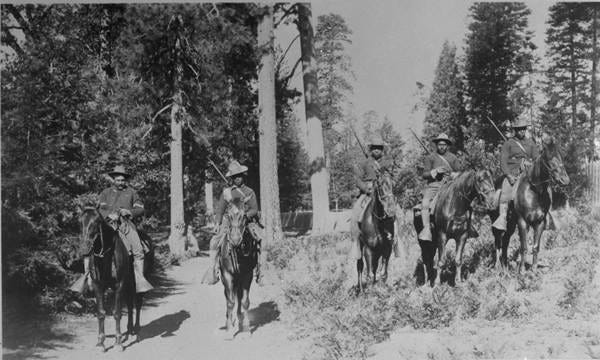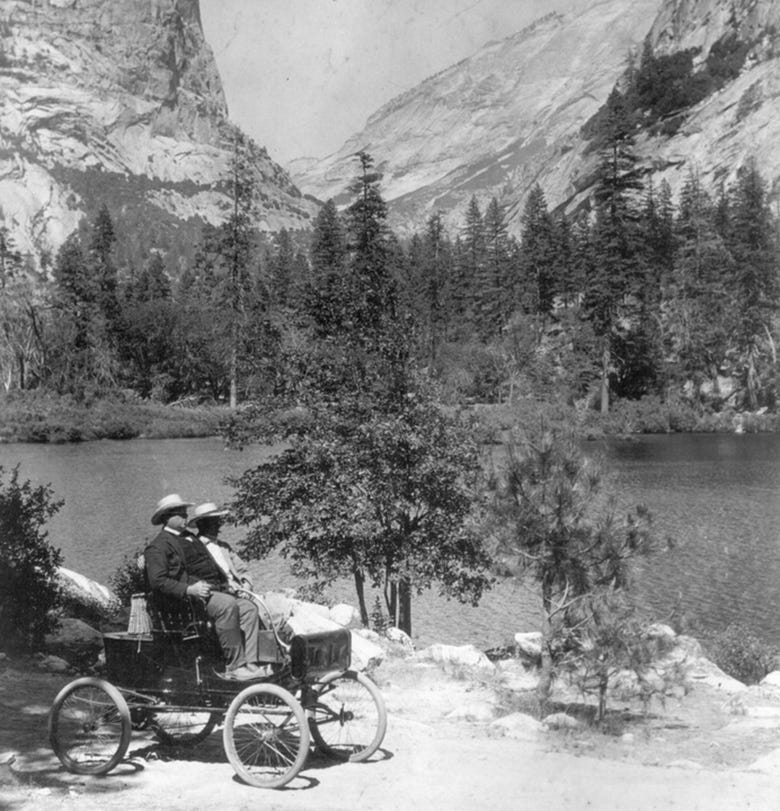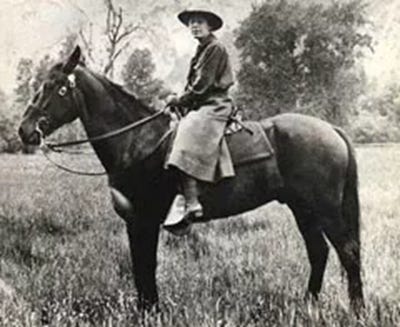“It is by far the grandest of all of His special temples of Nature I was ever permitted to enter. It must be the sanctum sanctorum of the Sierras.”
John Muir wrote these words following his awe-inspiring arrival to the glacier-sculpted Yosemite Valley in the spring of 1868. Just four years earlier, President Abraham Lincoln signed the Yo-Semite Valley Grant Act, which was the first time the federal government protected land in perpetuity “upon the express conditions that the premises shall be held for public use, resort, and recreation.” This special place, along with the Mariposa Big Tree Grove, was granted to the State of California, which meant it was not a national park. While Yellowstone has the distinction of being the first official National Park (in 1872), Yosemite was the first park established by the U.S. government for scenic and recreational purposes. Yosemite was a park of many firsts. In 1899, it was managed and protected by the first African American park rangers—the Buffalo Soldiers. These wilderness warriors fought wildfires, arrested poachers, stopped illegal logging and grazing, constructed roads and trails, and created the first arboretum in a national park, which is also considered to be the first museum in a national park.[i] You can learn more about these conservation pioneers in last week’s post. Although not permitted, Yosemite was the first national park to be touched by an automobile, when in 1900 photographer Oliver Lippincott and his mechanician Edward Russel drove their steam-powered Locomobile up the Yosemite Valley, along Mirror Lake, and over Glacier Point Road for publicity photos.[ii] Automobiles were not allowed in Yosemite until 1913. In 1918, Yosemite's Clare Marie Hodges became the first woman park ranger in the National Park Service. Yosemite was also the first national park with a tourism impact study, drafted in 1865 by Frederick Law Olmsted. In his report, Olmsted warned “the slight harm which the few hundred visitors of this year might do, if no care were taken to prevent it, would not be slight, if it should be repeated by millions.”[iii] Olmsted had fantastic foresight.



Last summer, my family were four of the more than 4 million annual visitors to Yosemite National Park. Our visit in July 2024 was similar to Muir’s 1868 tour of the park in that we were awed by nature’s majesty. The highlight of our trip was the 9-mile hike (round-trip) to the top of Yosemite Falls, the same one that Muir helped contour. We were on the trail shortly after sunrise, to beat the crowds. It took us about two hours to zig-zag the 2,500 feet of elevation up to the top of the Falls, where we were rewarded with panoramic views of the Sierra peaks, Sentinel Rock, Half Dome, and the verdant valley. The day was early enough where we had a couple of the overlook rocks to ourselves. Well, except for the pesky squirrel who tried to steal our snacks. As we enjoyed the fresh air and fresh views, more people arrived. Most only stayed for a few minutes, just enough time to get a selfie and take a breath before heading back down. Aaralyn, Griffin, and I explored around and spotted a plunge pool at the top of the falls. We slid down the slick granite, kicked off our shoes, and jumped in. Cool water never felt so good. It is difficult to describe this experience in words, so I include some photos below to help paint the picture. Suffice it to say, it was one of the most valuable deposits in my memory bank.
I feel fortunate to be able to visit America’s last best places. Last summer’s family roadtrip to the western national parks of Big Bend, Saguaro, Joshua Tree, Sequoia, Kings Canyon, Yosemite, and Death Valley was nothing short of spectacular. But it was expensive and took a lot of planning. Most of the expense was lodging. Staying in the John Muir Lodge for three nights in Kings Canyon National Park cost almost $1,000, and this was the cheapest option in the park. I realize most Americans cannot afford this experience. From a substack post earlier today, More Than Just Parks details why The Average American Can No Longer Afford to Visit Their National Parks. We stayed in lodges and motels for two reasons. One is that by the time I started planning our 2024 summer roadtrip in December 2023, all the campsites in the national parks were already reserved. The other reason was that I figured our trailer tires would explode on the black asphalt of the Mojave Desert under the July heat. They definitely would have. Road temperatures were consistently above 120°F and it was 130°F when we pulled in to the aptly named Furnace Creek Visitor Center in Death Valley National Park (photo proof below). I have never felt heat like that in my life, and no one else had either. July 2024 was “the hottest month in history in the hottest place on Earth!”[iv]
For this summer’s roadtrip, I started planning a year ago. For many campgrounds in national parks and state parks, you must make a reservation at least nine months in advance to secure a spot. One of the most sought-after state parks is Custer State Park in South Dakota on account of its central location near Badlands National Park, Wind Cave National Park, Mount Rushmore National Memorial, Crazy Horse Memorial, Black Hills National Forest, Thunder Basin National Grassland, and Devils Tower National Monument. When I made my 4-night reservation for Custer State Park last December, I secured one of the last three campsites in the state park. The other campsite reservations for our 2025 roadtrip fell into place after that. This summer’s national park tour took more planning than last year’s, but by camping, it will be a lot cheaper. For example, our campsite in Yellowstone’s Grant Campground cost only $44/night, compared to more than $400/night if we stayed at one of the lodges. Another plus is that camping will connect us more to the nature of the national parks. We leave in a few days for our next national parks adventure. For this journey, we will head north to South Dakota where we will camp at Custer State Park while we visit Badlands National Park and Wind Cave National Park. We then travel to Theodore Roosevelt National Park in North Dakota, with a detour to Devil’s Tower National Monument along the way. From there, we head west to Glacier National Park and then southeast to Yellowstone and Grand Teton national parks. I’ll be gone for three weeks and disconnected during this time, so sorry, no new posts for the next three weeks. Until then, I hope you can find some time to connect with nature.
Word of the Week
The term memory bank has many connotations. The way I use it in this post is as a conceptual space in the human mind where memories are stored. Our family hike to the top of Yosemite Falls was a valuable deposit not only in my memory bank, but also my kids’. Griffin brought it up yesterday out of the blue, telling me that was the best hike ever and that nothing will ever top it. Challenge accepted. Surely there is a more memorable hike in Glacier or Yellowstone national parks? Making deposits to my children’s memory banks is the primary reason I plan these national park and state park trips every summer. By connecting them to nature and history in America’s last best places, I hope to plant the seed for them to grow into good social actors.
When I return from our 3-week roadtrip, a concept I want to explore more is the societal memory bank—the collective knowledge, experiences, and stories that shape a society's identity and understanding of its past, present, and future. This can include: (1) formal networks like archives and museums, (2) informal networks of oral history, cultural practices, and shared narratives, and (3) virtual networks of new knowledge like this newsletter. How do we assess the repository of a society's collective consciousness? Can historical awareness enhance cultural transmission, critical engagement, and social cohesion?
Song of the Week
Molly Tuttle is one of my favorite bluegrass artists. Her song Yosemite, a collaboration with Golden Highway and Dave Matthews, fits the title of this week’s post and also includes the resolution of a roadtrip. I put the YouTube link on top this week because the lyric video is pretty special. Enjoy.
Sometimes the road is the best remedy
How many more miles to Yosemite?
[i] Lewis, Ralph H. (1993). Museum Curatorship in the National Park Service 1904-1982. Department of the Interior, National Park Service, Cultural Resources, https://www.nps.gov/parkhistory/online_books/curatorship/index.htm.
[ii] https://www.nps.gov/yose/learn/historyculture/early-tourism-roads-and-trails.htm.
[iii] https://www.loc.gov/item/today-in-history/june-30/.
[iv] National Park Service (2024). Hottest Month in Death Valley History, https://www.nps.gov/deva/learn/news/hottest-month-in-death-valley-history.htm.












